All this and Sakamoto Maaya too?
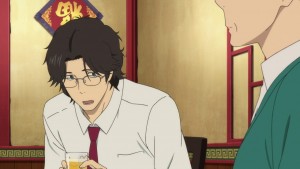 I love Fune wo Amu, but I almost feel like it should be in a display case in a museum somewhere with people wandering by occasionally to read the plaque and stare at it rather than be on TV. It’s kind of a waste to have a series this odd and inexplicable roll out the same way dozens of other mostly homogeneous anime do every season – I’d say it’s a throwback to an earlier era, but to be truthful there’s never really been an era where shows like this were remotely common.
I love Fune wo Amu, but I almost feel like it should be in a display case in a museum somewhere with people wandering by occasionally to read the plaque and stare at it rather than be on TV. It’s kind of a waste to have a series this odd and inexplicable roll out the same way dozens of other mostly homogeneous anime do every season – I’d say it’s a throwback to an earlier era, but to be truthful there’s never really been an era where shows like this were remotely common.
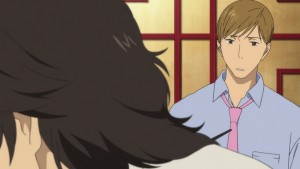 In a funny sort of way, Fune wo Amu reminds me a bit of Miyazaki – specifically, of Kaze no Tachinu, the great master’s inward-looking final feature. First off we have beautiful music as a companion (in this case, written by Ike Yoshihiro). There’s a great sense of reflection shared by both works, of what it means to be an iconoclast who sees beauty in places most normal people don’t. Kaze no Tachinu was of course quite autobiographical in nature despite nominally being about Horikoshi Jiro, and there’s no way Miura Shion could have written The Great Passage if she weren’t herself a lover of words.
In a funny sort of way, Fune wo Amu reminds me a bit of Miyazaki – specifically, of Kaze no Tachinu, the great master’s inward-looking final feature. First off we have beautiful music as a companion (in this case, written by Ike Yoshihiro). There’s a great sense of reflection shared by both works, of what it means to be an iconoclast who sees beauty in places most normal people don’t. Kaze no Tachinu was of course quite autobiographical in nature despite nominally being about Horikoshi Jiro, and there’s no way Miura Shion could have written The Great Passage if she weren’t herself a lover of words.
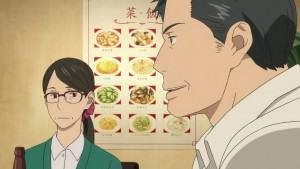 The Great Passage (yes, I like the English title so much I’m using it in the post headings) has an awful lot going for it to appeal to fans of esoterica like me. Words are like oxygen – we rely on them to survive every day, but we almost never spend any time thinking about them. One aspect of this show that I find especially fascinating is seeing the Japanese approach to the taming and classification of words studied in detail, because the Japanese language is so very different than our syllabary-driven languages. Much of the vocabulary comes from Kanji, which is a mix of ideograph and pictograph specimens, but it also must incorporate two syllabaries in Hiragana and Katakana (the latter of which contains all words of foreign origin – and modern Japanese is littered with them).
The Great Passage (yes, I like the English title so much I’m using it in the post headings) has an awful lot going for it to appeal to fans of esoterica like me. Words are like oxygen – we rely on them to survive every day, but we almost never spend any time thinking about them. One aspect of this show that I find especially fascinating is seeing the Japanese approach to the taming and classification of words studied in detail, because the Japanese language is so very different than our syllabary-driven languages. Much of the vocabulary comes from Kanji, which is a mix of ideograph and pictograph specimens, but it also must incorporate two syllabaries in Hiragana and Katakana (the latter of which contains all words of foreign origin – and modern Japanese is littered with them).
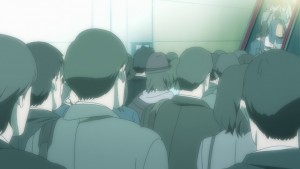 I don’t think it’s a stretch to say that I’m far more obsessed with language than the average person, but even I’ve rarely spent any time thinking about the way dictionaries are pulled together. In Japanese, lexicography for dictionaries like the Kojien (and presumably the Great Passage itself) are built around the Hiragana “50 sounds” – because, when you think about it, there would be almost no way to put together a Japanese lexicography around Kanji and have it be remotely usable. Are there enough viewers out there who care about stuff like this to give Fune wo Amu an audience, even in Japan? Well – the live-action won the Japanese Academy Award, so I guess there are at least a few.
I don’t think it’s a stretch to say that I’m far more obsessed with language than the average person, but even I’ve rarely spent any time thinking about the way dictionaries are pulled together. In Japanese, lexicography for dictionaries like the Kojien (and presumably the Great Passage itself) are built around the Hiragana “50 sounds” – because, when you think about it, there would be almost no way to put together a Japanese lexicography around Kanji and have it be remotely usable. Are there enough viewers out there who care about stuff like this to give Fune wo Amu an audience, even in Japan? Well – the live-action won the Japanese Academy Award, so I guess there are at least a few.
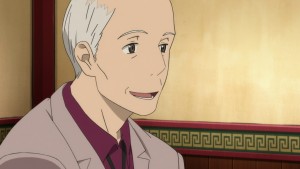 The process of building a dictionary from scratch is formidable and seemingly endless indeed. For a group like Matsumoto’s trying to put together an authoritative volume, the massive undertaking of gathering 230,000 “entry words” from the Kojien and others like it is only the beginning of the Sisyphean task. The real meat of The Great Passage is going to be the new words – the ones that aren’t in any of the three volumes it’s building on. Perhaps the notion of a print dictionary is archaic in our modern era – I hope not, but when one considers that a great dictionary must be both timeless and elastic, it’s easy to see why a reasonable person might feel that way.
The process of building a dictionary from scratch is formidable and seemingly endless indeed. For a group like Matsumoto’s trying to put together an authoritative volume, the massive undertaking of gathering 230,000 “entry words” from the Kojien and others like it is only the beginning of the Sisyphean task. The real meat of The Great Passage is going to be the new words – the ones that aren’t in any of the three volumes it’s building on. Perhaps the notion of a print dictionary is archaic in our modern era – I hope not, but when one considers that a great dictionary must be both timeless and elastic, it’s easy to see why a reasonable person might feel that way.
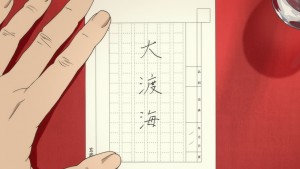 Speaking of archaic, that might be a very good word to describe Majime himself. A loner who lives in a boarding house with an aged widow and a cat as his only companions, who doesn’t even have a cell phone? Majime checks all the boxes – but if he weren’t a relatable protagonist, Fune wo Amu really wouldn’t fully function as a story. The thing is, Majime, for all his awkwardness, has something profound in his soul. He observes everything around him, he sees beauty in the patterns of life and language, and the world is a place filled with wonders and not just sources of potential embarrassment. I loved the story he told about escalators, not just because it tells us so much about Majime but because it’s so very true. I’ve seen that revelation myself and marveled at it (and having just spent some time on NYC subways, been reminded of just how different it is when you aren’t in Japan).
Speaking of archaic, that might be a very good word to describe Majime himself. A loner who lives in a boarding house with an aged widow and a cat as his only companions, who doesn’t even have a cell phone? Majime checks all the boxes – but if he weren’t a relatable protagonist, Fune wo Amu really wouldn’t fully function as a story. The thing is, Majime, for all his awkwardness, has something profound in his soul. He observes everything around him, he sees beauty in the patterns of life and language, and the world is a place filled with wonders and not just sources of potential embarrassment. I loved the story he told about escalators, not just because it tells us so much about Majime but because it’s so very true. I’ve seen that revelation myself and marveled at it (and having just spent some time on NYC subways, been reminded of just how different it is when you aren’t in Japan).
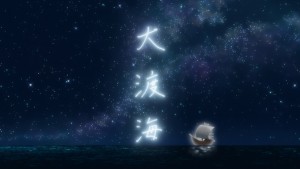 See, there’s a great truth and even beauty in stuff like that – but you have to be willing to see it when others see only the minutiae of everyday living. That’s what this group of square pegs in the dictionary editorial department, isolated and forgotten in the old headquarters building, really stands for. That makes them unconventional anime heroes to say the least, but to me that just makes them that much more admirable as characters. I suspect that’s the sort of thing viewers will either feel or they won’t, and that there won’t be much middle ground with The Great Passage.
See, there’s a great truth and even beauty in stuff like that – but you have to be willing to see it when others see only the minutiae of everyday living. That’s what this group of square pegs in the dictionary editorial department, isolated and forgotten in the old headquarters building, really stands for. That makes them unconventional anime heroes to say the least, but to me that just makes them that much more admirable as characters. I suspect that’s the sort of thing viewers will either feel or they won’t, and that there won’t be much middle ground with The Great Passage.



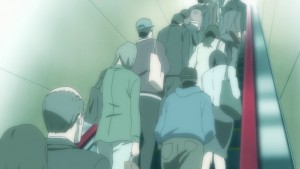
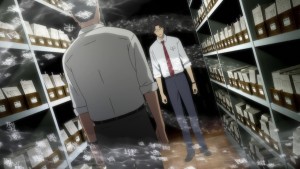

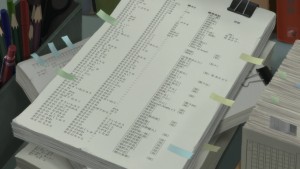
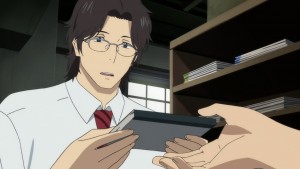
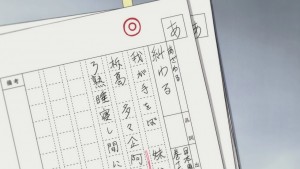
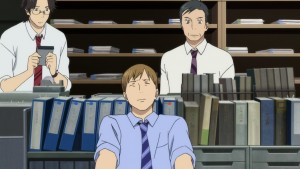
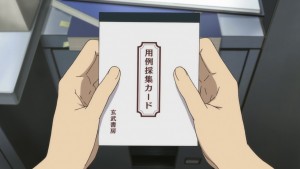
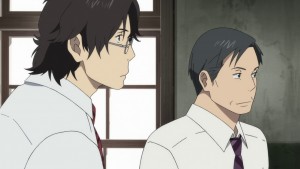
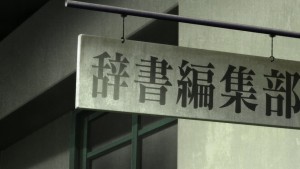

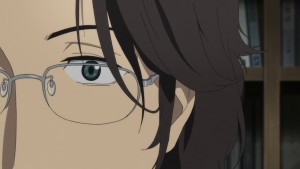



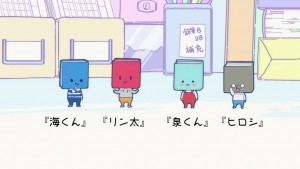

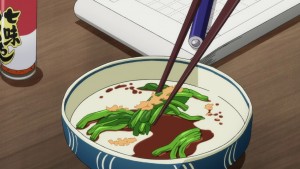
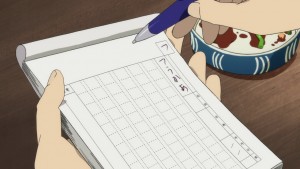

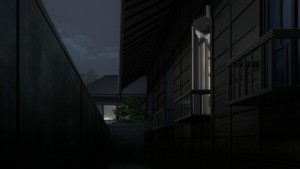
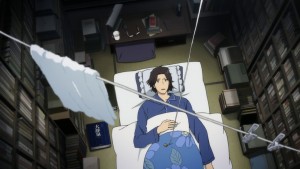
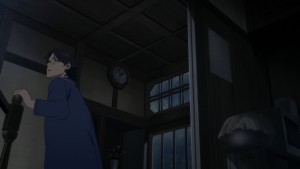
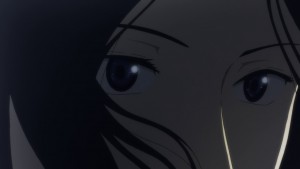


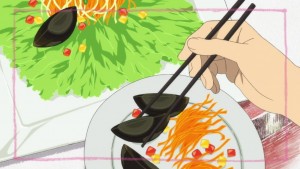

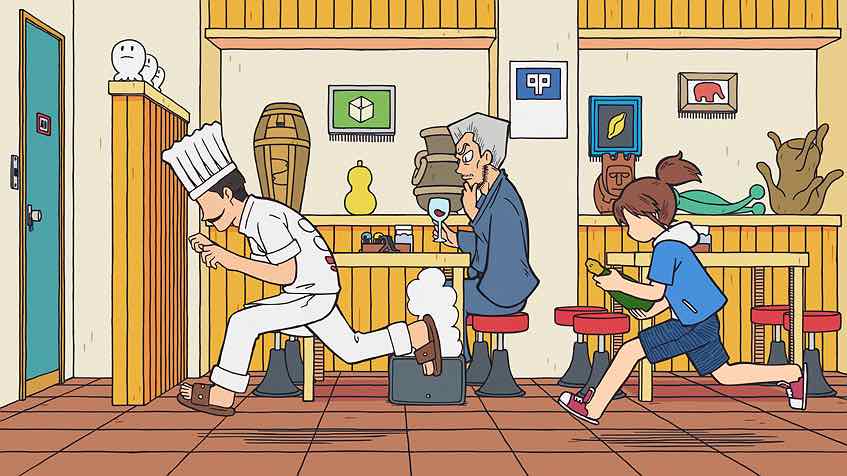
Flower
October 21, 2016 at 11:56 pmI feel the series subject matter and like the characters. Count me as totally signed up! XD
elianthos
October 22, 2016 at 1:58 amThis just keeps being beautiful :,> *just have to remember to mute the OP next time. Its arrangement just breaks that wonderful reflective mood very time >.< *
It's such a pity such a rare animal ended up in a rather… elusive streaming license deal.
Thanks for the extra bit about the 50 sounds as an alphabetical criterion of sort btw. From time to time I've wondered about what kind of compass they would pick given the nature of their writing system. Talking of which the water and airy whispy imagery is simple but complex and just so marvelously fitting. Every spoken word in any language is breath and air, but compared to our alphabet tradition – support included… our words have been first pressed or borderline plunged and stabbed into clay, scratched or carved in stone and wax, penned and imprinted on paper – kanji were born out ink brushstrokes… they’re fluid by nature.
Also… if there’s a unique enjoyiment to be had by just leafing through a book for dictionaries it can be even more so. Even the latetst editions by their printed quality are akin to a relic – a snapshot of the ever-changing live language – or shall we say a (big wonderfully rich ) message in a bottle ^^?
Earthling Zing
October 22, 2016 at 10:55 pmI know both shows have the same character designer, but Fune wo Amu really reminds me of Shouwa Genroku Rakugo Shinjuu. The character animation here is great.
Color2413
October 24, 2016 at 3:29 pmI am heartily grateful that something like this, a labor-of-love anime, even exists in 2016. I’m in!
Redice
October 24, 2016 at 9:15 pmNow i’ll admit Battery was a bit of a miss, but novels continue to be the best source for adaptations. Just so much creativity must go into adapting them.